Class VII: Chapter 4 - Air
Some important points to remember:
- The gaseous envelope around the earth's surface consisting of mixture of gases, water vapour and tiny dust particles is called atmosphere.
- The atmosphere has its own weight called atmospheric pressure.
- Concentration of gases and other constituents of atmosphere decrease with the increase in height.
- Atmosphere is endless with no visible boundary.
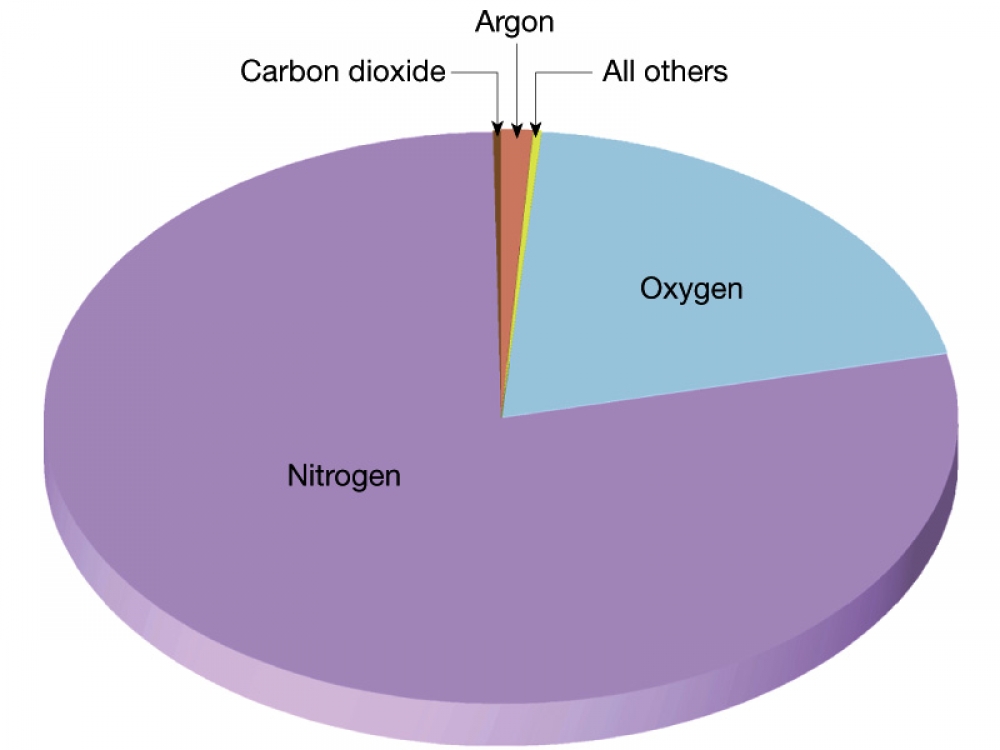
COMPOSITION OF ATMOSPHERE:
Atmosphere is composed of various gases. Major gases present are:
(a) Nitrogen – 78%
(b) Oxygen – 21%
(c) Argon - .93%
(d) Carbon Dioxide – 0.03%
(e) Other Gases – 0.04% (like – helium, hydrogen, methane, ozone, etc. and water vapours & dust particles.
Importance of atmosphere and various gases present in it are:
(a) Life giving gases like oxygen for breathing of animal kingdom and carbon dioxide is inhaled by plant kingdom.
(b) Ozone layer protects us from harmful ultraviolet rays of the sun.
(c) Tiny dust particles help in the formation of the rain droplets.
(d) It acts as a blanket which prevents the earth from becoming too hot during day and too cold during night.
(e) It protects us from falling meteors and other cosmic dusts. They burn when coming in contact with the atmosphere.
(f) Presence of gases, dust particles and water vapours lend colours to sky.
STRUCTURE OF ATMOSPHERE: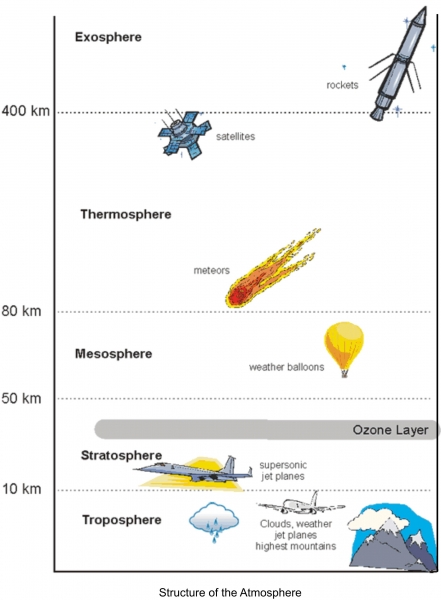
Atmosphere is divided into five different layers (Troposphere, Stratosphere, Mesosphere, Ionosphere and Exosphere). It extends upto 500 kms.
1. Troposphere:
- This layer is next to earth surface.
- It Extends upto 15 kms from the earth's surface.
- Temperature decreases at the rate of 1 degree Celsius from every 165 mtrs of ascent. This decline is known as normal lapse rate.
- Average height: 13 kms at poles and 18 kms over the equator.
- All weather changes take place in this layer.
- Oxygen exists in this layer.
- The boundary separating troposphere and stratosphere is known as tropopause.
2. Stratosphere:
- This layer is next to troposphere and it extends from 15 kms to 50 kms.
- This layer is free from weather changes, cloud formation and dust particles. Hence, this layer is ideal for the air transportation.
- Ozone layer is present here. Ozone layer absorbs/reflects the harmful ultraviolet rays of the sun.
- The boundary separating stratosphere and mesosphere is known as stratopause.
3. Mesosphere:
- This layer is next to stratosphere and it extends from 50 kms to 80 kms.
- Temperature again drops in this layer and can reach upto -100 degree Celsius at the upper boundary layer.
- The boundary separating mesosphere and ionosphere is known as mesopause.
4. Thermosphere:
- This layer is next to mesosphere and it extends from 80 kms to 400 kms.
- This layer contains electrically charged particles called ions, which are found at a height of 250 kms. Due to presence of these ions, this layer is also known as ionosphere.
- This layer protects us from the harmful radiation.
- Temperature increase with increase in height.
5. Exosphere:
- This is the uppermost layer above the ionosphere and it extends from 400 kms onwards and there is no end.
- It is a very thin layer and it merges with the space.
- This layer protects us from the harmful radiation.
- Temperature is very high.
- Light gases like hydrogen and helium float into space from here.
GLOBAL WARMING:
- Earth's atmosphere acts as a green house with the presence of harmful gases coming out from the factories, vehicles, refrigerators, etc.
- There is a layer of carbon dioxide around the earth which does not allow the heat to radiate into the space, rather this layer blocks the heat, due to which there is increase in the temperature. This increase in temperature is known as global warming.
- When the temperature increases – snow melts – due to which the water level increases causing floods.
- There may be major changes in the climate leading to the extinction of some vegetation and wildlife.
WEATHER: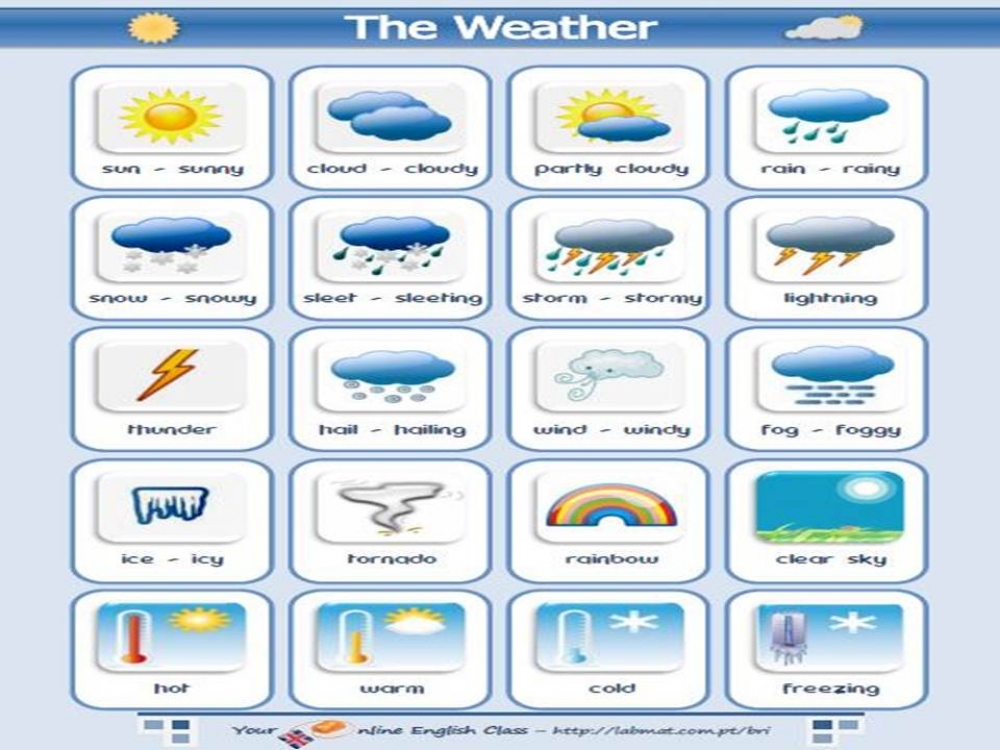
The condition of atmosphere at a particular place and time is known as weather.
METEOROLOGY:
The scientific study of weather is known as meteorology.
Temperature, pressure, wind, humidity, moisture, sunshine, precipitation, etc. are the major elements of weather and climate.
CLIMATE:
- The sum total or average of the weather conditions of a particular place over a longer period of time is known as climate.
- Climate influence the type of vegetation, agricultural crops grown, animals found, lifestyle, houses build, eating habits, etc.
INSTRUMENTS USED FOR MEASURING WEATHER:
1. Thermometer - Temperature
2. Barometer - Air Pressure
3. Rain Gauge - Rainfall
4. Wind Vane - Wind
& Anemometer

TEMPERATURE:
- The intensity of heat (warm or cold) is known as temperature.
- Main source of heat is sun.
- Surface temperature of sun is around 5500 degree Celsius.
- Heat energy given out by sun is known as solar radiation.
- Incoming solar radiation is known as insolation.
- The solar radiation takes 7 minutes to reach the earth's surface.
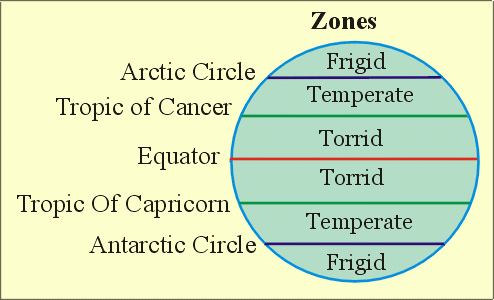
- Due to the spherical (round) shape of the earth, all parts does not receive same amount of insolation.
- On an around equator, insolation is maximum and it decrease when we move towards the poles.
- On the basis of the insolation received, earth is divided into different zones, which are as follows:-
1. Torrid Zone
2. Temperate Zone
3. Frigid Zone
_3_o.jpg) Heating and Cooling of Atmosphere:
Heating and Cooling of Atmosphere:
The heat energy given out by the earth is known as terrestrial radiation. It is the same heat which was absorbed by the earth through insolation.
Heat is transferred by the earth's surface into the atmosphere through the following ways: -
1. Conduction: The transfer of heat through contacts is known as conduction. In this, a cooler body comes in contact with the warmer body a gets heated up. This process is carried out until the temperature of both the bodies become same.
2. Convection: The actual movement of heat molecules from lower level to the higher level is known as convection. This process is common on equator and in tropics during the summers.
3. Advection: Transfer of heat from one place to another by the winds and the oceanic currents is known as advection. In this process, the cooler wind lowers the temperature of the warm wind and vice-versa, when they come in contact with each other.
4. Radiation: The process of releasing heat energy is known as radiation. The head energy absorbed by earth during the day time is radiated to the atmosphere during the night time.
Factors Affecting the Temperature:
Temperature is unequally distributed on the earth's surface and it differs from place to place. Factors controlling the temperature are as follows:
1. Latitude or distance from equator: Places located near the equator are warmer in comparison to the places located near the poles. Places near the equator receive direct sunrays because here the sunrays travel shorter distance and cover small area.
On contrary, in Polar Regions, sunrays travel longer distance and cover large area.
2. Altitude or height above the sea level: As we go higher the temperature decreases (i.e. 1 degree for every 165 metres). Mountainous areas are therefore cooler. The lower layers of atmosphere are denser and have water vapour and dust particles which absorb heat, which is not prevalent in the higher altitude. E.g. Missouri is cooler than Delhi.
3. Distance from the sea: The Sea is cooler than the land in summer, but warmer in winter. This is because it takes the sea a long time to heat up, but it is slower to cool down than land.
Areas experiencing uniform and mild temperature throughout the year as they are located near the sea have maritime type of climate. E.g. Mumbai.
Areas experiencing hot temperatures in summers and cold temperatures in winters due to longer distance from the sea have extreme or continental type of climate. E.g. Delhi.
4. Prevailing winds and ocean currents: Both winds and ocean currents (hot and cold) influence the temperature of the land. For e.g. hot and dry winds 'loo' in summers from Rajasthan increase the temperature of Delhi and in winters cold winds from Himachal Pradesh decreases the temperature of Delhi.
5. Slope of land: Slopes more exposed to sun, received more sunlight and these places are warmer. On contrary, slopes exposed less to sunlight are cooler and have less vegetation.
Temperature of a place is very important as it controls:
1. The presence or absence of water vapours or moisture.
2. Dryness or wetness of air and rainfall.
3. Type of crops to be grown.
4. Type of vegetation in an area.
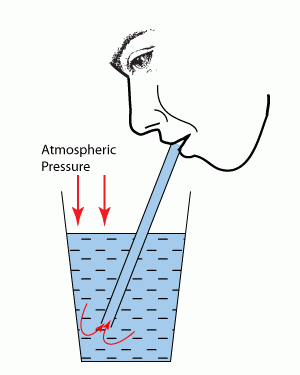
ATMOSPHERIC PRESSURE:
- The weight of air on the earth's surface is referred to as "Atmospheric Pressure".
- Weight of dry air is about 1.2 ounce per cubic foot of air.
- Pressure decreases with increase in height. Pressure is highest at the sea level.
- The air always moves from high pressure to low pressure areas.
- Barometer is the instrument through which pressure variation can be measured.
- Pressure is measured in millibars. Average atmospheric pressure at sea level is 1013 millibars.
Factors responsible for difference in the Atmospheric Pressure:
1. Variations in Temperature Conditions.
2. Changing Altitude.
Distribution of Atmospheric Pressure: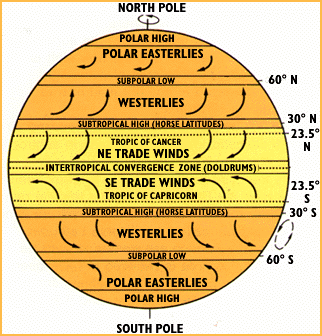
High Temperature – Low Pressure
Low Temperature – High Pressure
The world is divided into seven different pressure belts:
1. Equatorial low pressure belt also called "Doldrums".
2. Subtropical high pressure belt from 30 to 35 degree in North.
3. Subtropical high pressure belt from 30 to 35 degree in South.
4. Sub Polar low pressure belt from 65 degree in North.
5. Sub Polar low pressure belt from 65 degree in South.
6. Polar high pressure belt in North Pole.
7. Polar high pressure belt in South Pole.
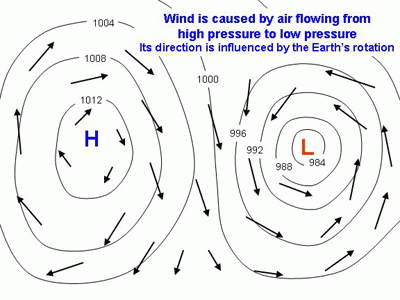
WIND:
- The movement of air from high pressure area to low pressure areas is called "Wind".
- Winds play a vital role as they are very important.
- Winds transports temperature and moisture from one place to another.
- Slope of pressure from high to low is known as "Pressure Gradient" and this decides the direction of the winds.
- Deflection of the winds is affected by the "Coriolis Force", which is caused by the rotation of the earth. Coriolis is absent on the equator and it increases towards the poles.
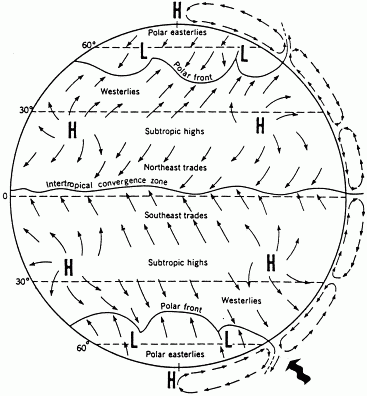
Types of Winds: Winds can be broadly divided into three types:
1. Permanent or Planetary Winds.
2. Seasonal or Periodic Winds.
3. Local Winds.
1. Permanent or Planetary Winds: These winds blow constantly throughout the year in a particular direction. These winds are broadly classified as: -
(a) Trade Winds
(b) Westerlies
(c) Polar Easterlies
(a) Trade Winds:
- These winds blow from Sub-Tropical high pressure belt towards Equatorial low pressure belt.
- They blow from North-East in the northern hemisphere and South-East in the southern hemisphere.
(b) Westerlies:
- These winds blow from Sub-Tropical high pressure belt to Sub-Polar low pressure belt.
(c) Polar Easterlies:
- These winds blow from Polar high pressure belt to Sub-Polar low pressure belt.
2. Seasonal or Periodic Winds: These winds change their direction in different seasons. The best example is "Monsoon Winds".
(a) Land Breeze: The offshore breeze is called "Land Breeze".
(b) Sea Breeze: The onshore breeze is called "Sea Breeze".
3. Local Winds: These winds blow only during a particular period of the day or year. These winds bring short time changes in the weather conditions over a smaller area. Some of the examples are: -
(a) Chinook: Chinook means 'snow eater'. These winds are strong, warm and dry. They blow in North America.
(b) Loo: These are hot and dry winds which, blow during the summer season in the northern part of India.
(c) Sirocco: These are hot and moist winds, which blow from Sahara desert to Mediterranean Sea.
(b) Mistral: These are very cold winds, which blow down from the Alps over France.
LOCAL STROMS:
- Stroms are very strong blowing winds and they are serious threat to life and property in the coastal areas.
- Cyclones, hurricanes, typhoons and tornadoes are some of the examples of stroms.
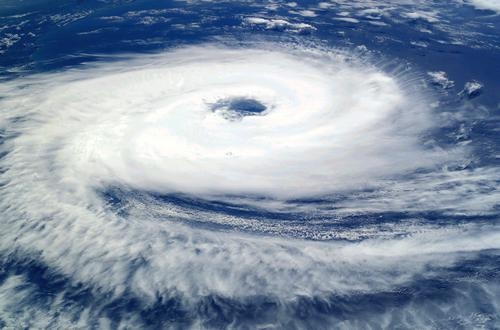
Cyclones:
- Cyclones refer to a violent and destructive form of winds followed by heavy rainfall.
- Cyclonic winds cause 7 to 10 km high tidal waves that sweep 20 kms inland and bring massive destruction.
- Hurricanes are type of cyclones, which are experienced by eastern coast of India.
Prevention:
These are the natural calamities which cannot be prevented but we can try to minimize the effect by the following ways:
1. People should live far away from the coastal lands.
2. Houses should be constructed with stronger building material.
Instruments:
1. Wind Vane is used to measure the direction of the wind.
2. Anemometer is used to measure the wind velocity.
CASE STUDY
CYCLONE IN ORISSA
On 29th of October 1999, a cyclone (hurricane) emerged from the Bay of Bengal. With winds up to 300 km/h and 30 feet tidal waves, it affected the state of Orissa for more than 36 hours. The impacts on people and the environment were massive because of poor preparation.
Effects:
- 20,000 people and 700,000 cattle died.
- 90 million trees have been uprooted or damaged.
- 20 million people were made homeless
- 5 million farmers are out of work
- 1.2 million hectares of standing cropland were destroyed.
- £1.5Billion damage
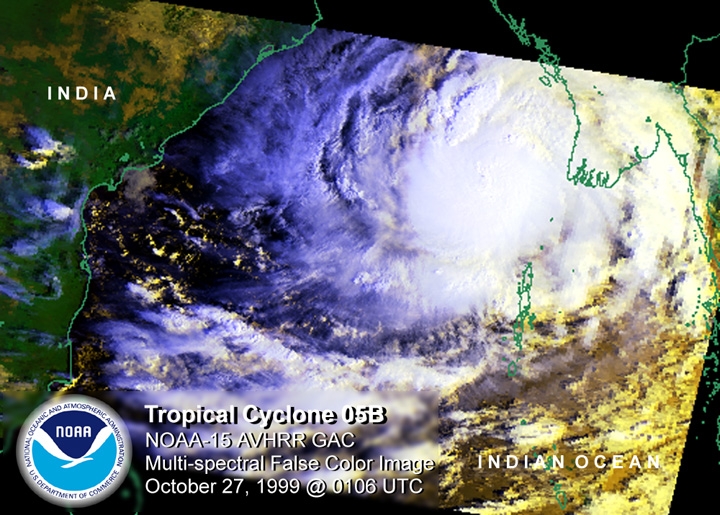
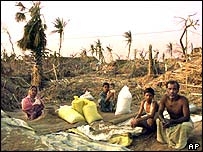
MOISTURE:
- Moisture content in air is called "Humidity".
- When the air is full of water vapour we call it a humid day. As the air gets warmer, its capacity to hold the water vapour increases and so it becomes more and more humid. On a humid day, clothes take longer to dry and sweat from our body does not evaporate easily, making us feel very uncomfortable.
- Instrument used to measure humidity is called "Hygrometer".
- Temperature at which air gets saturated is known as "Dew Point".
- When the water vapour rises, it starts cooling. The water vapour condenses causing formation of droplets of water. Huge masses of water droplets are known as "Clouds". When these droplets of water become too heavy to float in air, then they come down as precipitation.
- Types of precipitation: Rainfall, Snowfall, Hail, Sleet, etc. A very tiny drop of rain water is called "Drizzle".
TYPES OF RAINFALL:
Rainfall can be classified into three types:
1. Convectional Rainfall: Sudden and heavy rainfall
2. Relief Rainfall: The windward side of the mountains receives heavier rainfall in comparison to that of the other side.
3. Cyclonic Rainfall: Rainfall is associated with cyclones.

POLLUTION:
- Any change in the composition of air is termed as "Air Pollution".
- Some of the air pollutants are: Chlorofluorocarbons (CFC), Carbon Dioxide, Carbon Monoxide, Shulphur Dioxide, Nitrogen Oxide, etc.
- Some of the hazards of air pollutions are: Health problems, Loss of biodiversity, Damage to the historical monuments (e.g. Taj Mahal is getting harmed), etc.
- Serious steps should be taken to protect the environment and the human life.
-----x-----X-----x-----
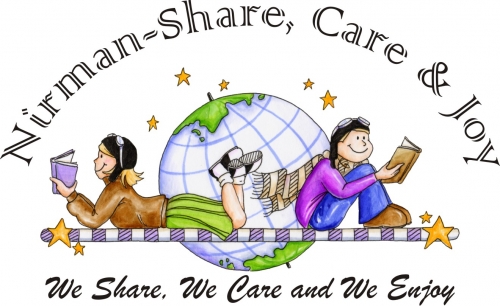

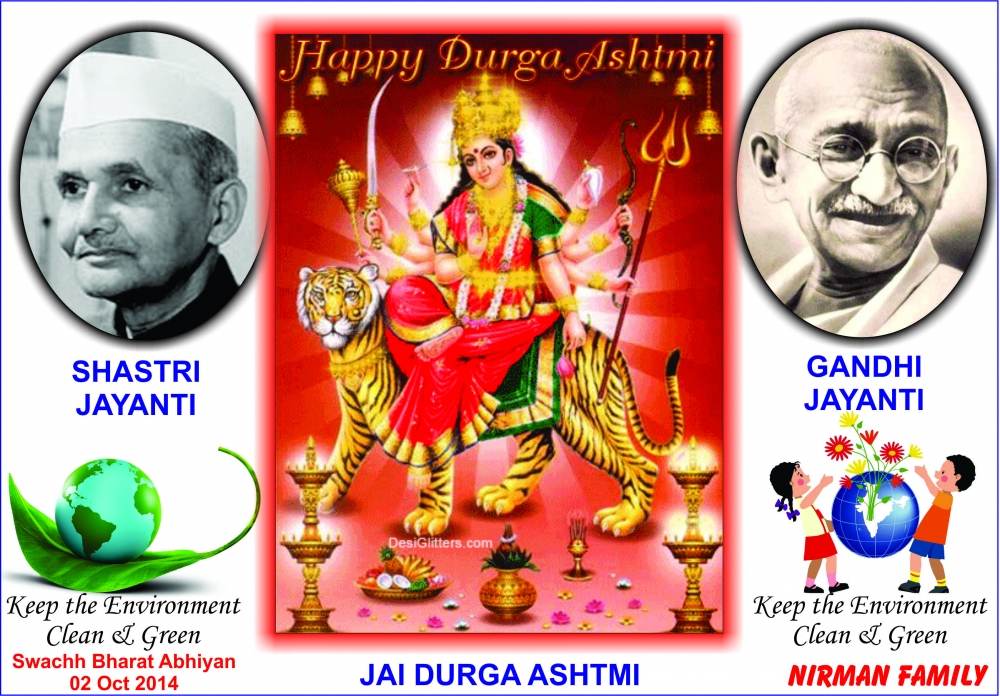
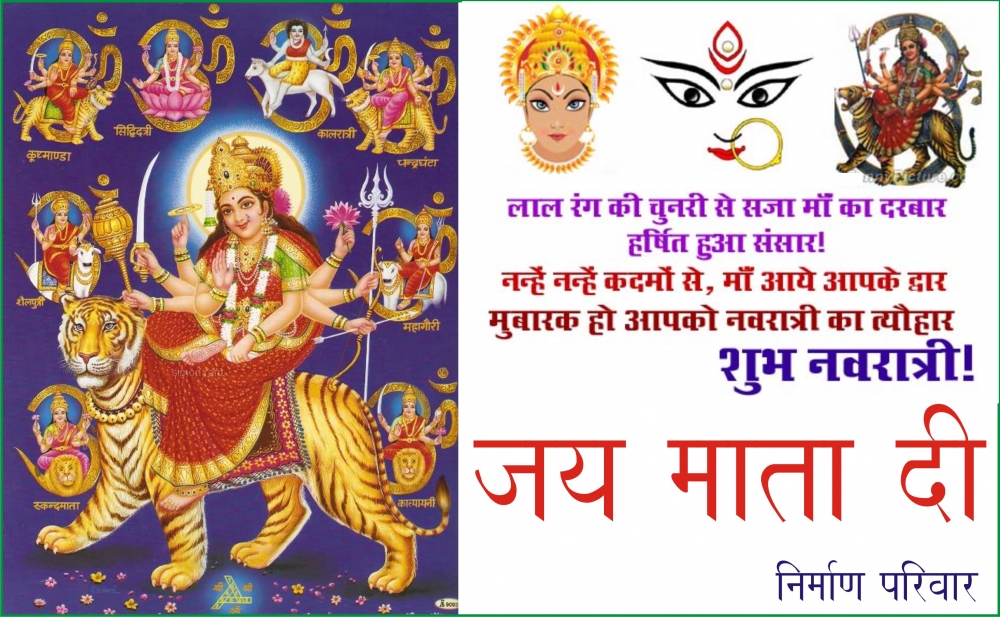

_0_o.jpg)
_0_o.jpg)